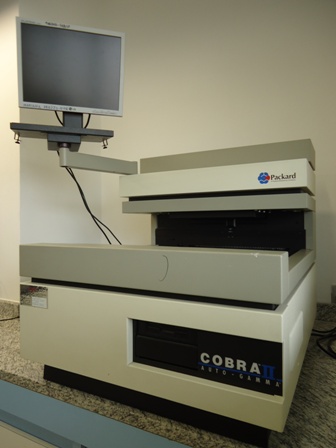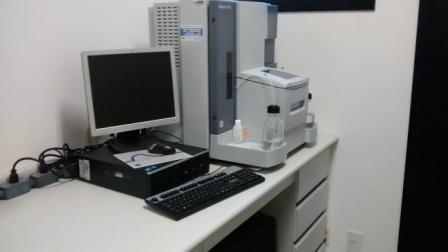AKTA AVANT 25 |
||
 |
||
AKTA avant is a preparative chromatography system designed for fast and secure development of scalable methods and processes. |
||
| Leia outras especificações no site do Fornecedor | ||
| Laboratório Glicobiologia C - 6° andar | ||
| Responsável Técnico: Profa. Dra. Helena Nader |
||
BIOLUMINESCÊNCIA IVIS 200 |
||
 |
||
Real-Time Fluorescent and Bioluminescent Fast Imaging |
||
| Leia outras especificações no site do Fornecedor | ||
| Laboratório Multiusuário 8 | ||
| Responsável Técnico: Meire Ogussuko |
||
Profª. Responsável: Profª. Drª. Juliana Dreyfuss Modelo: IVIS Kinetic Marca: Caliper LifeSciences Nº de patrimônio 126518 UNIFESP Financiamento: CT/INFRA-FINEP Localização: INFAR – UNIFESP Rua Três de Maio, 100 - São Paulo, SP. |
||
CENTRÍFUGA REFRIGERADA HITACHI |
||
 |
||
| Laboratório Multiusuário 10 | ||
| Responsável Técnico: |
||
Modelo: Himac CR 21 Marca: Hitachi
INFAR – UNIFESP Rua Três de Maio, 100 - São Paulo, SP. |
||
CIRCULAR DICHROISM SPECTROMETER - CHIRASCAN™ |
||
 |
||
Suitable for studying chiral molecules of all types and sizes. Often used to analyze biomolecules, Chirascan data contributes to a deeper understanding of biomolecular characteristics, mechanisms and interactions. Chirascan sets new standards for steady-state circular dichroism spectroscopy. It incorporates innovative optical design features to maximise light throughput, particularly in the far-UV wavelength region, and a sophisticated digital data acquisition system that facilitates the rapid collection of more accurate and precise CD spectra. Chirascan’s digital CD spectra acquisition approach ensures that unmodified CD spectra are collected and any post-acquisition smoothing of the CD spectra will be non-distorting and completely reversible. This approach also simplifies the operation – Chirascan is as straightforward to use as a single-beam spectrophotometer |
||
| Leia outras especificações no site do Fornecedor | ||
| Laboratório Multiusuário 1 | ||
| Responsável Técnico: Profa. Dra. Helena Nader |
||
CITÔMETRO DE FLUXO BD FACSARIA III |
||
 |
||
The BD FACSAria™ III is built on the solid foundation of patented technologies, superior multicolor performance, and legendary ease-of-use that has led to the unparalleled success of the BD FACSAria. Since the introduction of the first BD FACSAria in 2003, each successive generation has opened the complex world of cell sorting to a broader audience of researchers and wider range of applications. Now, the BD FACSAria III system is even more powerful, dependable, and easy to use. |
||
| Leia outras especificações no site do Fornecedor | ||
| Laboratório Multiusuário 4 | ||
| Responsável Técnico: Beth/Carol |
||
Modelo: BD FACSAria III Cell Sorter Marca: Becton Dickson Financiamento: EMU FAPESP Localização: INFAR – UNIFESP Rua Três de Maio,100 - São Paulo, SP.
|
||
CITÔMETRO DE FLUXO BD FACSCALIBUR |
||
 |
||
The flow cytometer for your routine cell analysis needs The BD FACSCalibur™ platform offers a unique modular approach to flow cytometry and allows users to perform both cell analysis and cell sorting in an innovative single benchtop system. Designed with multicolor application support in mind, the BD FACSCalibur flow cytometer provides flexibility to support a wide variety of research and clinical applications |
||
| Leia outras especificações no site do Fornecedor | ||
| Laboratório Multiusuário 4 | ||
| Responsável Técnico: Beth/Carol |
||
BD FACSCalibur Modelo: Becton Dicknson 56874 Marca: Becton Dicknson Nº. de patrimônio 56.874 UNIFESP Financiamento: EMU FAPESP
Localização: INFAR – UNIFESP Rua Três de Maio, 100 - São Paulo, SP. |
||
CONTADOR DE CINTILAÇÃO E LUMINESCÊNCIA MICRO BETA JET |
||
 |
||
General Description MicroBeta JET is a multi-detector in-strument designed for liquid scintilla-tion or luminescence detection of sam-ples in microtitration plates, tubes or on filters. |
||
| Leia outras especificações no site do Fornecedor | ||
| Laboratório Multiusuário 1 | ||
| Responsável Técnico: |
||
Modelo: 1450 LSC & Luminescence Counter Marca: Perkin Elmer Software – Wallar Micro Beta Nº. de patrimônio 72.011 UNIFESP Localização: INFAR – UNIFESP Rua Três de Maio,100 - São Paulo, SP. |
||
CRIOSTATO THERMOSCIENTIFIC MICROM HM 550 |
||
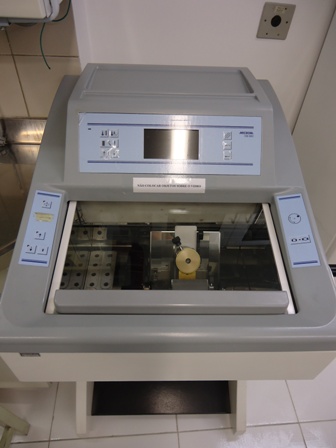 |
||
Thermo Scientific Microm HM 550
The HM 550 provides a perfect solution for high volume, demanding |
||
| Leia outras especificações no site do Fornecedor | ||
| Laboratório Multiusuário 3 | ||
| Responsável Técnico: Jacilene Barbosa |
||
Modelo: HM 550OP Marca: Microm GMBH Nº. de patrimonio 73597 UNIFESP Financiamento: EMU FAPESP
Localização: INFAR – UNIFESP Rua Três de Maio,100 - São Paulo, SP. |
||
ESPECTROFLUORÍMERO RF-6000 |
||
 |
||
By combining new technologies with those cultivated over Shimadzu's long history, the Shimadzu spectrofluorophotometer has been reborn as the RF-6000. Combined with new LabSolutions RF software, designed for unrivaled measurement accuracy and easy operation, the RF-6000 offers the ultimate performance for a diverse range of customers' measurement needs. |
||
| Leia outras especificações no site do Fornecedor | ||
| Laboratório Glicobiologia A - 4º andar | ||
| Responsável Técnico: Aline Mendes |
||
ESPECTROFOTÔMETRO UV-1800 |
||
 |
||
The UV-1800 is an advanced high-resolution spectrophotometer utilizing a precision Czerny-Turner optical system. Operation can be either as a stand-alone instrument or as a PC-controlled instrument with the included UV Probe software. USB memory can be connected directly to the UV-1800 for simple data transfer and printing is possible with the optional screen-copy printer or printers that support PCL control codes. Includes the following modes: Photometric, Spectrum, Quantitation, Kinetics, Time-Scan, Multi-Component Quantitation and Biomethod. |
||
| Leia outras especificações no site do Fornecedor | ||
| Laboratório Glicobiologia A - 4º andar | ||
| Responsável Técnico: Aline Mendes |
||
ESPECTRÔMETRO DE INFRAVERMELHO FT-IR PROTEIN ANALYZER |
||
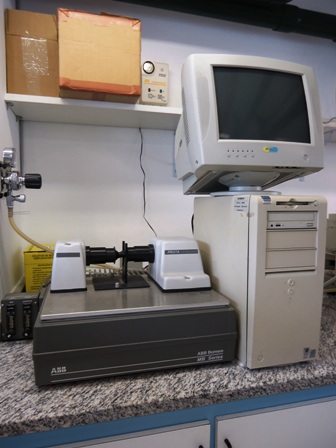 |
||
Formulation studies (liquids and solids) - effects of excipients, pH and buffers Determination of secondary structures of de new proteins Conformational stability and dynamics Structure in aggregates Mutation studies Structural characterization upon environmental effects Stability studies (thermal and chemical) Drug delivery Protein-protein, protein-DNA/RNA and protein-drug interactions Crystallization condition screening |
||
| Leia outras especificações no site do Fornecedor | ||
| Laboratório Multiusuário 1 | ||
| Responsável Técnico: |
||
Modelo: Prota FT-IR Protein Analyzer Marca: ABB Bomem MB Series |
||
ESPECTRÔMETRO DE MASSA ÍON TRAP THERMO LXQ (LC/MS) |
||
 |
||
Thermo Electron has introduced the Finnigan™ LXQ™, a new cost-effective linear ion trap mass spectrometer that delivers high performance for rapid, reliable analysis supporting high-throughput solutions for today's fast paced analytical laboratories that will find the Finnigan LXQ to be an attractive option for HT drug discovery and proteomics. It provides superior speed and sensitivity over 3D ion traps, combined with the ruggedness that Finnigan ion traps have delivered for years. |
||
| Leia outras especificações no site do Fornecedor | ||
| Laboratório Multiusuário 1 | ||
| Responsável Técnico: |
||
Modelo: Finningan LXQ Marca: Thermo Electron Corporation Nº. de patrimônio 87.688 UNIFESP Localização: INFAR – UNIFESP Rua Três de Maio,100 - 6o andar, São Paulo, SP.
|
||
ESPECTRÔMETRO STOPPED-FLOW SX-20 APPLIED PHOTOPHYSICS |
||
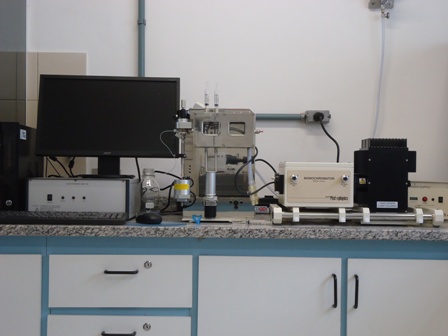 |
||
The gold standard for stopped-flow kinetics
The SX20 is the premier high performance stopped-flow spectrometer, built on over 20 years of innovative design and applications support.
The SX20 is used to study transient and pre-steady-state kinetics of fast, liquid-phase chemical and biochemical reactions initiated by the rapid mixing and stopping (stopped-flow) of the reactants. A spectroscopic probe (absorbance or fluorescence) is employed to follow the course of the reaction by recording changes in the amplitude of the spectroscopic signal as a function of time. A typical upper limit to the reaction rates that can be measured with stopped-flow is ~2000s-1 in standard configuration; with smaller volume cells, rates in excess of 3000s-1 can be measured.
The wide range of applications for stopped-flow spectroscopy means there are many thousands of publications. The study of enzyme catalysis, protein refolding, signal transduction, ligand or drug binding to proteins or DNA and kinetics of coordination chemistry are numbered among the many applications of stopped-flow spectroscopy.
The SX20 is the undisputed market leader in stopped-flow. Applied Photophysics has supplied more than half of all the stopped-flow instruments in use today. |
||
| Leia outras especificações no site do Fornecedor | ||
| Laboratório Multiusuário 1 | ||
| Responsável Técnico: |
||
Modelo: SX-20 Marca: Applied Photophysics Financiamento: AR FAPESP – Ivarne Tersariol Localização: INFAR – UNIFESP Rua Três de Maio, 100 - São Paulo, SP.
|
||
ESPECTROPOLARÍMETRO (DICROÍSMO CIRCULAR JASCO) |
||
 |
||
|
||
| Leia outras especificações no site do Fornecedor | ||
| Laboratório Multiusuário 1 | ||
| Responsável Técnico: |
||
Modelo: J – 810 – 1505 Marca: Jasco Nº. de patrimônio 62.541 UNIFESP Localização: INFAR – UNIFESP Rua Três de Maio,100 - São Paulo, SP. |
||
ESTEREOMICROSCÓPIO COM SISTEMA DE EPIFLUORESCÊNCIA COM FILTROS PARA GFP, CFP E TEXAS RED |
||
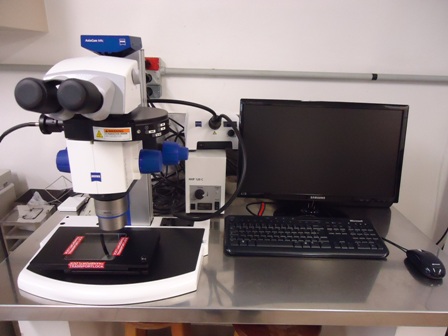 |
||
SteREO Discovery.V8:
|
||
| Leia outras especificações no site do Fornecedor | ||
| Laboratório Multiusuário 10 | ||
| Responsável Técnico: |
||
Modelo: Stereo Discovery V.8 Marca: Zeiss Localização: INFAR – UNIFESP Rua Três de Maio,100 - São Paulo, SP.
|
||
ESTUFA PARA BACTÉRIAS |
||
 |
||
| Laboratório Multiusuário 10 | ||
| Responsável Técnico: |
||
Modelo: EB-60 Marca: Labtrade
Localização: INFAR – UNIFESP Rua Três de Maio, 100 - São Paulo, SP. |
||
ESTUFA PARA C. ELEGANS (1) |
||
 |
||
| Laboratório Multiusuário 10 | ||
| Responsável Técnico: |
||
Modelo: EL 101/1 Marca: EletroLab
Localização: INFAR – UNIFESP Rua Três de Maio, 100 - São Paulo, SP. |
||
ESTUFA PARA C. ELEGANS (2) |
||
 |
||
| Laboratório Multiusuário 10 | ||
| Responsável Técnico: |
||
Modelo: EL 101/1 Marca: EletroLab
Localização: INFAR – UNIFESP Rua Três de Maio, 100 - São Paulo, SP. |
||
ESTUFA PARA FUNGOS |
||
 |
||
| Laboratório Multiusuário 10 | ||
| Responsável Técnico: |
||
Modelo: EB-60 Marca: Labtrade
Localização: INFAR – UNIFESP Rua Três de Maio, 100 - São Paulo, SP. |
||
FLUXO LAMINAR HORIZONTAL PARA C. ELEGANS |
||
 |
||
| Laboratório Multiusuário 10 | ||
| Responsável Técnico: |
||
Modelo: PA 220 Marca: Pachane
Localização: INFAR – UNIFESP Rua Três de Maio, 100 - São Paulo, SP. |
||
FLUXO LAMINAR VERTICAL PARA BACTÉRIAS |
||
 |
||
| Laboratório Multiusuário 10 | ||
| Responsável Técnico: |
||
Modelo: PA-310 Marca: WR Research Products
Localização: INFAR – UNIFESP Rua Três de Maio, 100 - São Paulo, SP. |
||
FLUXO LAMINAR VERTICAL PARA FUNGOS |
||
 |
||
| Laboratório Multiusuário 10 | ||
| Responsável Técnico: |
||
Modelo: PA-310 Marca: WR Research Products
Localização: INFAR – UNIFESP Rua Três de Maio, 100 - São Paulo, SP. |
||
FOTODOCUMENTADOR PARA GÉIS E MEMBRANAS COM FILTRO UV E VISÍVEL - MF-CHEMIBIS |
||
 |
||
Breakthrough Robotic camera- allows placement very close to the sample, resulting in very high sensitivity and superior image quality under a wide range of conditions. High resolution- selectable scientific camera (2.0 Mpixel, 3.2 Mpixel) gives maximum band separation and best quality images. Unrivalled sensitivity- high speed super bright lens collects maximum light from the sample while maintaining crisp, clear images with minimal geometric and light distortion. Novel Deep Liquid Cooling System- cools the camera to minimum of -70°C for better accuracy, longer exposure time and minimal dark noise. Illumination versatility- 10 types of illumination sources to suite a wide range of samples and applications. Fully automated and motorized- permits simultaneous control of a number of settings such as: zoom, focus, gain and more, for easier image capture and faster results Fluorescence - Ethidium bromide, SYPRO™ Orange, SYPRO™ Red, Cy ™ 2, Cy ™ 3, Pro-Q™ Diamond, Deep Purple™, Rhodamine Red, SYPRO™ Ruby, SYBR™ Green, GelStar™, SYBR™ Gold, Fluorescein, Texas Red™, GFP, and more Colorimetric- Silver Stain, Coomassie Brilliant Blue, film, and more Chemiluminecsence - ECL™, ECL-Plus™, Lumi Light Plus™, Super Signal™, CDP Star™, CSPD™ |
||
| Leia outras especificações no site do Fornecedor | ||
| Laboratório Multiusuário 3 | ||
| Responsável Técnico: Jacilene Barbosa |
||
Fotodocumentador Modelo: DNR – Bio Imaging System M. Chemi BIS Marca: DNR Nº. de patrimônio: 109.563 Financiamento: CAPES |
||
FOTODOCUMENTADOR UVITEC CAMBRIDGE (6º ANDAR) |
||
Alliance 4.7
• Ideal for resolution demanding applications such as 1D quantification, 2D gel, multiplexing, biofluorescence and western blots • No compromise: the best of dedicated chemi system and gel-doc gathered in one system • Massive 16-bit performance • Dynamic range up to 4.8 orders of magnitude • Extreme 4.2 Megapixels resolution - 1.1 inch sensor • Dynamic range up to 4.8 orders of magnitude • Extremely bright fixed lens (f:0,95) • Unique twin cooling system • Patent pending UVI-PURE technology available • "One touch" fully automated image acquisition program • USB super-fast connection |
||
| Leia outras especificações no site do Fornecedor | ||
| Laboratório Multiusuário 3 | ||
| Responsável Técnico: Jacilene Barbosa |
||
FREEZERS -80°C |
||
 |
||
| Laboratório Multiusuário 9 | ||
| Responsável Técnico: Elsa Yoko |
||
Localização: INFAR – UNIFESP Rua Três de Maio,100 - Térreo - São Paulo, SP. |
||
LABORATÓRIO COM EQUIPAMENTOS PARA MANUSEIO DE FONTES RADIOATIVAS |
||
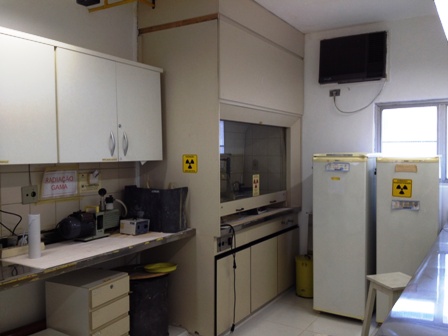 |
||
| Laboratório Multiusuário 2 | ||
| Responsável Técnico: Profª. Drª. Mariana Araujo |
||
LEITORA DE PLACAS PARA FLUORESCÊNCIA, FLUORESCÊNCIA POLARIZADA, ABSORBÂNCIA E LUMINESCÊNCIA, COM MICRO-INJEÇÃO AUTOMÁTICA (FLEX) |
||
 |
||
FlexStation 3 Benchtop Multi-Mode Microplate ReaderA 5-mode microplate reader that offers flexibility to address a wide spectrum of biochemical- and cell-based applications, while matching all assay throughput requirements.FlexStation® 3 Benchtop Multi-Mode Microplate Reader combines Molecular Devices’ SpectraMax® M5e Multi-Mode Microplate Reader performance with an integrated 8- or 16-channel pipettor into one compact benchtop reader. The FlexStation 3 Microplate Reader high-efficiency monochromator optics are tunable for absorbance, fluorescence intensity, fluorescence polarization, and time-resolved fluorescence assays. It also has a dedicated photomultiplier tube for luminescence assays. Users have several choices when configuring the FlexStation 3 Microplate Reader. Users can choose from 96-well pipetting, 384-well pipetting, or both. Once installed, the pipettors can be changed by the user with no tools in under 5 minutes. The FlexStation 3 Microplate Reader is supplied with SoftMax® Pro Microplate Data Acquisition & Analysis Software, Molecular Devices’ industry leading all-in-one data acquisition and analysis software. Among the various ready-to-read protocols, users will find pre-written SpectraDrop™ Micro-Volume protocols enabling micro volume applications measurement. |
||
| Leia outras especificações no site do Fornecedor | ||
| Laboratório Multiusuário 1 | ||
| Responsável Técnico: |
||
Modelo: Flex Station 3 Marca: Molecular Devices Financiamento: Projeto AR FAPESP – Alice Teixeira Localização: INFAR – UNIFESP Rua Três de Maio,100 - São Paulo, SP.
|
||
MICROSCÓPIO CONFOCAL LEICA TCS SP8 CARS |
||
 |
||
For imaging with the Leica TCS SP8 CARS confocal microscope, specimen do not have to be stained. The Coherent anti-Stokes Raman Scattering (CARS) technology involves two laser beams to visualize the vibrational contrast of molecules in specimens. The specimen remains almost unaffected. The user profits of a wide range of live cell imaging with the combination of visible, IR and UV lasers, second harmonic generation and CARS such as analyzing living cells, tissues and even small whole animals at high speed or at high resolution. With its flexibility and convenient handling, the Leica TCS SP8 CARS is the ideal device for research institutes and multi-user facilities. CARS MicroscopyCARS (Coherent Anti-Stokes Raman Scattering) microscopy is a dye-free method which images structures by displaying the characteristic intrinsic vibrational contrast of their molecules. The crucial advantage of this method is that the sample remains almost unaffected. It does not require labeling but uses the spectroscopic properties of various chemical species found in organic material.
|
||
| Leia outras especificações no site do Fornecedor | ||
| Laboratório Multiusuário 5 | ||
| Responsável Técnico: Prof. Dr. Marcelo A. Lima |
||
FAPESP - Auxílio Pesquisa - Equipamentos Multiusuários Nº 2013/08154-7 Coordenador:
Localização: INFAR – UNIFESP Rua Três de Maio, 100 - Térreo, São Paulo, SP. |
||
MICROSCÓPIO CONFOCAL SP8 |
||
 |
||
Leica TCS SP8 has been designed for confocal microscopy with optimal photon efficiency and high speed. All optical components are matched towards preserving fluorescence photons for image contrast and to improve cell viability in live cell imaging. Backing up this sensitive detection are a high speed scanning system with up to 428 frames per second, large field of view of field number 22 and accelerated Z-stacking by a novel mode for the SuperZ galvanometer called Galvoflow. This suits the instrument for the most demanding samples, highest speed while offering full confocal resolution. The Leica TCS SP8 delivers publication ready images out of the box along with comprehensive upgrade options. |
||
| Leia outras especificações no site do Fornecedor | ||
| Laboratório Multiusuário 4 | ||
| Responsável Técnico: Beth/Carol |
||
Modelo: SP8 Marca: LEICA Financiamento: AR H.B. Nader Localização: INFAR – UNIFESP Rua Três de Maio,100 - São Paulo, SP.
|
||
MICROSCÓPIO CONFOCAL ZEISS LSM 780 |
||
 |
||
Obtain Quantitative Information About Your Cells and Individual Molecules The sensitivity of LSM 780 is quite simply outstanding. The GaAsP detector achieves 45 percent quantum efficiency compared to 25 percent typically by conventional PMT detectors. This results in accurate details and contrast-rich images of the challenging specimens you encounter in your live cell imaging. |
||
| Leia outras especificações no site do Fornecedor | ||
| Laboratório Multiusuário 6 | ||
| Responsável Técnico: Beth/Carol |
||
FAPESP - Auxilio Pesquisa-Regular Nº 2009/52430-3 Coordenadores: Soraya Soubhi Smaili Alice Teixeira Ferreira Helena Bonciani Nader
INFAR – UNIFESP Rua Três de Maio, 100 - Térreo, São Paulo, SP. |
||
MICROSCÓPIO DE CAMPO CLARO E FLUORESCÊNCIA (5º ANDAR) |
||
 |
||
For transmitted light/brightfield, phase contrast and epi-fluorescence techniques Capable and expandable, with a perfect range for routine high-throughput applications. Inverted design places illumination at top, stage below, and optics on the bottom, for microscopic study of large specimens by transmitted light. Ideal for routine examination of specimens in all kinds of culture vessels, glass and plastic vessels, including cell culture vessels. Use with microtest and microtitration plates, too. Integrated lightpath for photo and video documentation is standard. |
||
| Leia outras especificações no site do Fornecedor | ||
| Laborátório Microscópio de Fluorescência - 5º Andar | ||
| Responsável Técnico: |
||
Microscópio de Fluorescência Modelo: AXIO Marca: ZEISS Nº. de patrimônio: 107.637 Financiamento: CAPES
Localização: INFAR – UNIFESP Rua Três de Maio, 100 - São Paulo, SP. |
||
MICROSCÓPIO LEICA COM DETECTORES ULTRARRÁPIDOS (MENSURAÇÕES RACIOMÉTRICAS) E LASER DE TIRF |
||
 |
||
Visualize previously unseen information about a specimen and improve scientific research with MultiColor TIRF (Total Internal Reflection Fluorescence) from Leica Microsystems. This system offers four integrated solid-state lasers for excitation of fluorophores in all important wavelengths. The short switching times, fully automated alignment automatically-constant TIRF penetration depth when switching from one wavelength to another, and high synchronized image recording rate open up completely new horizons for researching dynamic processes in live cells. The system integrates four wavelengths; 405nm, 488nm, 561nm, and 635nm; with fast AOTF control. |
||
| Leia outras especificações no site do Fornecedor | ||
| Laboratório Multiusuário 4 | ||
| Responsável Técnico: Beth/Carol |
||
Modelo: AM TIRF MC Marca: LEICA Financiamento: JP FAPESP Egdar
Localização: INFAR – UNIFESP Rua Três de Maio, 100 - São Paulo, SP. |
||
MICROSCÓPIO ÓPTICO INVERTIDO |
||
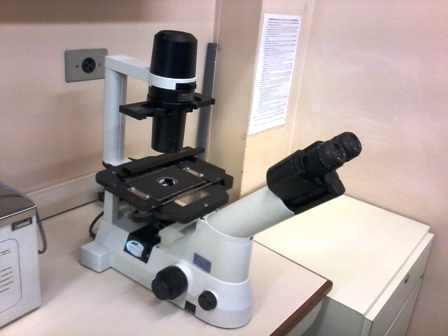 |
||
| Leia outras especificações no site do Fornecedor | ||
| Laboratório Multiusuário 7 | ||
| Responsável Técnico: Mariana Silva (Aluna Pós-Doc da Profª. Maria Luiza) |
||
Profª. responsável: Profª. Drª. Mariana Araujo
Marca Nikon TS100
Localização: INFAR – UNIFESP Rua Três de Maio, 100 - São Paulo, SP. |
||
MICROSCÓPIO SUPER-RESOLUÇÃO LEICA SR GSD 3D |
||
 |
||
LEICA SR GSD 3D – 3D LOCALIZATION WITH GROUND STATE DEPLETION Setting New Standardsin 3D Localization Precision Stochastical optical reconstruction microscopy (GSDIM or dSTORM) can achieve super-resolution images with a lateral resolution of down to 20 nm. However the
|
||
| Leia outras especificações no site do Fornecedor | ||
| Laboratório Multiusuário 6 | ||
| Responsável Técnico: Beth/Carol |
||
Localização: INFAR – UNIFESP Rua Três de Maio, 100 - São Paulo, SP. |
||
MICRÓTOMO LEICA SM2010 R |
||
 |
||
With smooth movement of the sledge, precision specimen orientation, and emphasis on safety and ergonomics, the Leica SM2010 R produces high quality sections for routine histopathology (paraffin), neuroscience (fixed frozen brain) and industrial applications (foam and wood). The stable sliding microtome has a totally enclosed micrometer feeding system with an ergonomically positioned object head close to the user. The smooth running sledge can be locked in 11 positions by using the easily accessible sledge brake. |
||
| Leia outras especificações no site do Fornecedor | ||
| Laboratório Multiusuário 3 | ||
| Responsável Técnico: Jacilene Barbosa |
||
Modelo: SM 2010R Marca: Leica Financiamento: FAPESP 2007/53732-8 - aquisição em 2011
Localização: INFAR – UNIFESP Rua Três de Maio, 100 - São Paulo, SP. |
||
PERKIN-ELMER LAMBDA 25 UV/VISIBLE SPECTROPHOTOMETERS |
||
 |
||
The Perkin-Elmer Lambda™ 25UV/Visible Spectrophotometers increase productivity to generate high-quality results the first time, every time. The LAMBDA 25 is an ideal match for most routine UV/Vis applications and regulatory tests, giving fast and reliable results time. LAMBDA systems are easy to operate and deliver results the user can trust with the minimum of operator training. UV WinLab™ software works the way the user works, guiding the user through a step-by-step process that simplifies analysis from sample entry to report generation, eliminating costly mistakes and delivering rapid results. Applications for UV-VIS spectroscopy include quantification of nucleic acids, proteins, and cells, as well as monitoring enzyme reactions, along with a variety of other uses. |
||
| Leia outras especificações no site do Fornecedor | ||
| Laboratório Glicobiologia B - 4° andar | ||
| Responsável Técnico: Aline Mendes |
||
REAL TIME – PCR APPLIED 7500 |
||
 |
||
The 7500 Real-Time PCR System is a powerful platform for labs requiring superior performance and maximum dye versatility. This system is a sophisticated platform for users who require extended capabilities and maximum versatility. The 3rd generation platform features an innovative optical system that enhances sensitivity and lets you access a broader range of fluorophores. The variable excitation capability allows greater sensitivity for longer wavelength (red) dyes. |
||
| Leia outras especificações no site do Fornecedor | ||
| Laboratório Multiusuário 3 | ||
| Responsável Técnico: Jacilene Barbosa |
||
Modelo: 7500 – Real Time PCR System Marca: Applied Biosystems Nº. de patrimônio 72.009 UNIFESP
Localização: INFAR – UNIFESP Rua Três de Maio, 100 - 6o andar, São Paulo, SP. |
||
REAL TIME – PCR APPLIED 7500 |
||
 |
||
The 7500 Real-Time PCR System is a powerful platform for labs requiring superior performance and maximum dye versatility. This system is a sophisticated platform for users who require extended capabilities and maximum versatility. The 3rd generation platform features an innovative optical system that enhances sensitivity and lets you access a broader range of fluorophores. The variable excitation capability allows greater sensitivity for longer wavelength (red) dyes. |
||
| Leia outras especificações no site do Fornecedor | ||
| Laboratório Multiusuário 3 | ||
| Responsável Técnico: Jacilene Barbosa |
||
Modelo: 7500 – Real Time PCR System Marca: Applied Biosystems Nº. de patrimônio 72.009 UNIFESP Financiamento: EMU FAPESP Localização: INFAR – UNIFESP Rua Três de Maio,100 - 6o andar, São Paulo, SP. |
||
SEQÜENCIADOR DE DNA - MODELO 377 SISTEMA DE GEL |
||
 |
||
The ABI PRISM®
|
||
| Leia outras especificações no site do Fornecedor | ||
| Laboratório Multiusuário 3 | ||
| Responsável Técnico: Jacilene Barbosa |
||
Modelo: 377 – DNA Sequencer - ABI Prism Marca: Applied Biosystems Nº. de patrimônio 62.522 UNIFESP Financiamento: EMU FAPESP
Localização: INFAR – UNIFESP Rua Três de Maio,100 - 6o andar, São Paulo, SP. |
||
SEQUENCIADOR DE DNA MODELO 3130 SISTEMA CAPILAR |
||
 |
||
With the Applied Biosystems 3130 Genetic Analyzer, you get the sophisticated automation and superior performance of the 3130 system, at acquisition and operating costs tailored to a growing research lab.
|
||
| Leia outras especificações no site do Fornecedor | ||
| Laboratório Multiusuário 3 | ||
| Responsável Técnico: Jacilene Barbosa |
||
Modelo: 3130 Genetic Analyzer Marca: Applied Biosystems Nº. de patrimônio 126516 UNIFESP Financiamento: EMU FAPESP
Localização: INFAR – UNIFESP Rua Três de Maio,100 - 6 o andar, São Paulo, SP. |
||
SISTEMA DE CROMATOGRAFIA LÍQUIDA AKTA PURE |
||
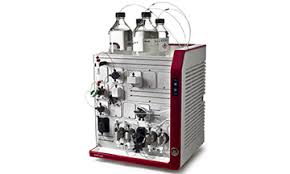 |
||
Flexible and intuitive chromatography system for fast purification of proteins, peptides, carbohydrates and nucleic acids from microgram to gram levels of target product. These applications are supported by affinity chromatography, size exclusion chromatography (SEC, also known as gel filtration), ion exchange chromatography, hydrophobic interaction chromatography, and reversed phase chromatography (RPC). SOLICITAÇÃO EM ANÁLISE PELA FAPESP |
||
| Leia outras especificações no site do Fornecedor | ||
| Laboratório Glicobiologia C - 6° andar | ||
| Responsável Técnico: Aline Mendes e Maria Cecília Meneghetti |
||
Formas de agendamento: telefone: (11) 5576-4444 Ramais: 1188 e-mail: cicazm@gmail.com
Dias disponíveis: De segunda à sexta-feira, das 08h às 17h, conforme prévio agendamento. |
||
SISTEMA DE MICROSCOPIA DE CAMPO CLARO E FLUORESCÊNCIA |
||
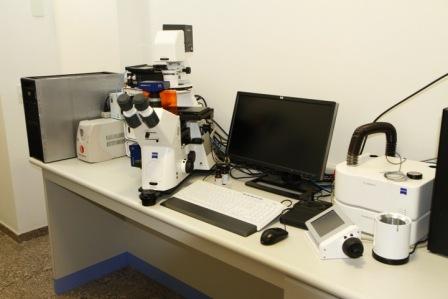 |
||
Descrição do sistema: Fabricante: Carl ZeissMicroImaging O sistema é composto por um Microscópio Invertido AxioObserver Z1 (Eixo motorizado) que possui um display touchscreen para visualização de todos os comandos do microscópio: campo claro, contraste de fases, DIC (contraste de interferência diferencial) e fluorescência DG4. O microscópio apresenta configuração para ensaios com preparações fixadas e cultura de células e está equipado com aparato de climatização para estudos celulares com controle da temperatura, CO2 e umidade. A platina motorizada (Maerzhaeuser) pode receber o suporte universal (lâminas e placas de petri), e também está disponível o adaptador (com aquecimento) para placa multiwell (24 poços). Com essa configuração é possível realizar ensaios de longa duração com células mantidas em cultura, com controle de temperatura e CO2. Os acessórios do sistema estão relacionados abaixo:
Objetivas: PlanNeofluar 5x (0.16) Plan Neofluar 10x (0.3) LD Plan Neofluar 20X (0.4) LD PlanNeofluar 40X (0.6) C- Apochromática 40x (1.2) PlanNeofluar 63X (1.25)
Filtros de fluorescência: Jogo 20 (Rodamina) Jogo 21 HE (fura-2) Jogo 25 (DAPI/FITC/Texas Red) Jogo 31 (Cy 3) Jogo 38 Jogo 40 (AMCA/FITC/TRITC) Jogo 49 (DAPI) Jogo 77 (Cy5) (obs: os filtros podem ser utilizados por uma grande variedade de indicadores, não apenas os mencionados acima. Consultar o site abaixo para detalhes dos espectros dos filtros). |
||
| Leia outras especificações no site do Fornecedor | ||
| Equipamentos Multiusuários (FAPESP/EMU-2010) - Pesquisa II | ||
| Responsável Técnico: Thaysa Paschoalin |
||
email: tpaschoalin@unifesp.br telefone: 5576-4450 Ramal 1977
Localização: Edifício de Pesquisa II – UNIFESP Rua Pedro de Toledo 100, 7o andar, São Paulo, SP. |
||
TERMOCICLADOR |
||
 |
||
A highly sophisticated temperature cycling instrument designed to automate the GeneAmp Polymerase Chain Reaction (PCR) Technique. |
||
| Leia outras especificações no site do Fornecedor | ||
| Laboratório Multiusuário 3 | ||
| Responsável Técnico: Jacilene Barbosa |
||
Modelo: 2400 – Gene Amp – PCR System Marca: Applied Biosystems Nº. de patrimônio 62.523 UNIFESP Localização: INFAR – UNIFESP Rua Três de Maio,100 - 6o andar, São Paulo, SP.
|
||
TRI-CARB 4910TR 110 V LIQUID SCINTILLATION COUNTER |
||
 |
||
The Tri-Carb 4910TR liquid scintillation counter provides the popular standard features needed for research applications and the versatility to expand for environmental analysis with the optional ultralow-level and alpha/beta discrimination features. |
||
| Leia outras especificações no site do Fornecedor | ||
| Laboratório Glicobiologia A - 4º andar | ||
| Responsável Técnico: Aline Mendes |
||
TYPHOON™ FLA 9500 |
||
 |
||
Typhoon FLA 9500 is a robust and versatile laser scanner that is ideally suited to multiuser environments. Biomolecular imaging applications include sensitive and quantitative measurements of Western blots, multiplex fluorescence, and radioisotopic labels by storage phosphor as well as digitization of colorimetric stains. |
||
| Leia outras especificações no site do Fornecedor | ||
| Laboratório Glicobiologia A - 4º andar | ||
| Responsável Técnico: Aline Mendes |
||
ULTRASSOM PARA ANIMAIS DE PEQUENO PORTE VEVO 2100 |
||
 |
||
The Vevo 2100 High-Resolution Imaging System comprises a number of technological breakthroughs in the field of high frequency ultrasound; the most notable of which are the development of high frequency linear arrays for the purpose of imaging small animals in a preclinical setting. |
||
| Leia outras especificações no site do Fornecedor | ||
| Laboratório Multiusuário 8 | ||
| Responsável Técnico: Meire Ogussuko |
||
Profª. Responsável: Profª. Drª. Juliana Dreyfuss Modelo: Vevo 2100 Image Systems Marca: Visual Sonics Financiamento: CT/INFRA-FINEP
Localização: INFAR – UNIFESP Rua Três de Maio,100 - São Paulo, SP. |
||
VERSAMAX MICROPLATE READER |
||
 |
||
The VersaMax™ Microplate Reader is an affordable, tunable microplate reader for 96-well format. The VersaMax reader uses a grating monochromator to select the wavelength, so the exact wavelength needed can be selected for every assay. With a wavelength range from 340 to 850 nm, this is equivalent to having 510 free filters. |
||
| Leia outras especificações no site do Fornecedor | ||
| Laboratório Glicobiologia B - 4° andar | ||
| Responsável Técnico: Aline Mendes |
||
VICTOR X4 |
||
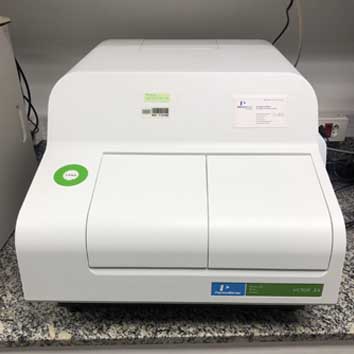 |
||
VICTOR X4 offers several detection methods: luminescence, fluorescence intensity (both top and bottom reading), UV-absorbance (UV-VIS), and time-resolved fluorescence (TRF) technologies. Specifications: Visible Absorbance: 340-1000 nm; UV Absorbance: 260/280 nm; Luminescence: glow, flash and dual luminescence; Time Resolved Fluorescence (TRF): dual window TRF and dual emission measurements; Fluorescense Intensity: top and bottom fluorescence (340-850 nm; when using optional red-sensitive photomultiplier tube (PMT); Tungsten-halogen lamp and Xenon flash lamp. Compatible with all types of microplates between 1 and 1536 wells, WorkOut Plus MMD software; Dual label measurements; Compatible with Petri plates, slides, filters and PCR plates. Temperature range: up to + 50 °C. 8-position excitation filter wheel for flexible and versatile use of filters. Blue photomultiplier tube (standard). Area scanning up to 100 points/well. Optical system: filter; Plate formats: 96, 384 well plates. |
||
| Leia outras especificações no site do Fornecedor | ||
| Laboratório Glicobiologia A - 4º andar | ||
| Responsável Técnico: Aline Mendes |
||
ZEISS AXIO OBSERVER A1 INVERTED FLUORESCENCE PHASE CONTRAST MICROSCOPE |
||
 |
||
Axio Observer is your stable research stand for demanding multimodal imaging of living and fixed specimens. This inverted microscope offers the latest generation of LED illumination for gentle imaging. And creates the optimal environment for a whole range of samples to deliver reliable, reproducible data. |
||
| Leia outras especificações no site do Fornecedor | ||
| Laboratório Glicobiologia B - 4° andar | ||
| Responsável Técnico: Aline Mendes |
||






